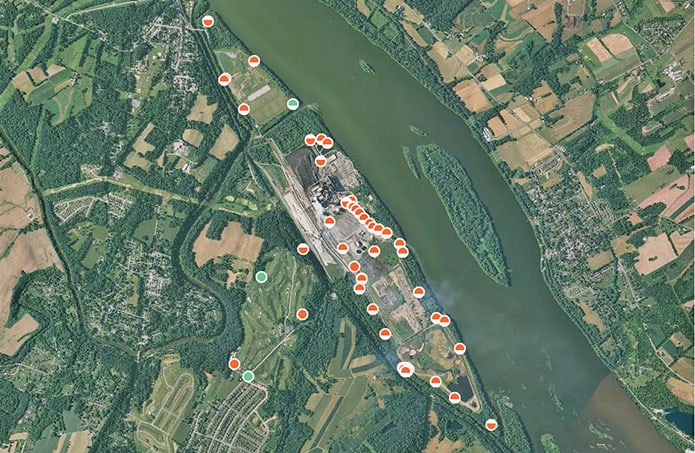By Whitney Pipkin, Bay Journal News Service
Just after Virginia legislators voted to end the storage of coal ash in pits where it could leach into groundwater and rivers, a report released in March revealed widespread coal-ash contamination in 39 states — and at more than 91 percent of the power plants monitored. They include sites in Maryland, Pennsylvania and Virginia.
This image from AshTracker.org, an Environmental Integrity Project website, shows the location of monitoring wells for the Brunner Island Power Plant coal ash site along the Susquehanna River in Pennsylvania. Almost all of the 70 monitoring wells, marked with red and green dots, detected groundwater pollution, according to AshTracker.org.The report by Earthjustice and the Environmental Integrity Project relies on monitoring data from coal-fired power plants that an Obama era regulation required them to release for the first time in 2018. Of the 265 power plants that were impacted by the requirement, the report found that groundwater near 242 of them contained “unsafe levels” of one or more pollutants from coal ash. It also cited a coal ash landfill in Maryland’s Patuxent River watershed as one of the 10 worst coal ash contamination cases in the country.
The snapshot of the industry “confirms that virtually all coal [ash sites] are polluting our groundwater,” said Abel Russ, senior attorney with the EIP and lead author of the report.
Coal ash, the byproduct of burning coal for power, can contain toxic chemicals and heavy metals such as arsenic, lead and mercury. Environmental lawyers and researchers have been trying to prove how easily these contaminants can leach from unlined or clay-lined pits into groundwater and, eventually, enter drinking water and nearby waterways.
The data used to produce the report came from groundwater monitoring wells on or near the coal ash storage sites, and includes both sites with ongoing pollution problems and sites where the pollution has been addressed.
But Jim Roewer, executive director of the Utility Solid Waste Activities Group, which represents the dozens of utilities that generate waste while producing energy, said the data show that the federal rules regulating coal ash are working — and that more analysis is needed to determine whether the pollution actually exceeds legal standards.
“It is important to note that even if the required monitoring finds groundwater impacts in the shallow groundwater immediately next to a disposal unit on power plant property, this does not necessarily mean that neighbors’ drinking water is affected or that a health risk exists,” Roewer wrote in a statement.
Sites that do exceed groundwater allowances under the federal rule, he noted, already are required to eventually take corrective action.
Among the sites included in the report are nine in Pennsylvania, six in Virginia and three in Maryland, though not all are inside the Chesapeake Bay watershed.
According to the report, one of the 10 worst coal ash contamination cases lies within the Bay watershed at the Brandywine Coal Ash Landfill near Mataponi Creek, a tributary to the Patuxent River, in Prince George’s County, MD. Ash from three coal plants has been collected for years at the site, where groundwater was contaminated with unsafe levels of at least eight pollutants, including lithium at more than 200 times greater than safe levels and molybdenum (which can damage the kidney and liver) at more than 100 times greater than what is considered safe.
The Maryland Department of the Environment sued the facility for violations of the Clean Water Act and state laws. A $1.9 million settlement was reached in early 2013, and triggered cleanup efforts.
An EIP attorney at the time lauded the penalties as one of the toughest she’d seen a state impose on a coal ash site.
In Virginia’s portion of the Bay watershed, a power station in Yorktown made the list for leaching unsafe levels of arsenic, beryllium and other pollutants into not only groundwater but also the drinking water for about 55 residents in the years leading up to 1980. About 25 drinking water wells near a golf course in Chesapeake, VA, where coal ash was used as structural fill, had elevated levels of boron and other contaminants, the report states.
Virginia’s governor signed into law in March a bill that requires coal ash to be excavated from four impoundments located along Virginia rivers and then recycled or placed in lined landfills. Water quality advocates vehemently opposed previous plans by Dominion Energy’s to permanently store the ash in the existing pits.
Earthjustice and other national and local groups are pushing for similar legislation in North Carolina and Illinois.
In the new report, the Brunner Island Power Plant, just south of Harrisburg on the Susquehanna River, posted unsafe levels of contaminants such as arsenic, nitrate and lead in 64 of its 70 groundwater monitoring wells in samples between 2011 and 2017. Run by Talen Energy, the plant still burns coal for fuel but is adding natural gas-firing capabilities and has “closed” several of its onsite coal ash storage pits while sending the coal ash that is currently generated to another unlined basin at the plant, according to the report.
A water discharge permit for the plant expired in 2006, and the EIP has submitted comments to the Pennsylvania Department of Environmental Protection asking that the permit be updated to include modern pollution controls. The nonprofit also filed a notice of intent to sue in August.
A generating station north of Pittsburgh, outside of the Bay watershed, was among the report’s 10 most contaminated sites for posting levels of arsenic in the groundwater that were 372 times greater than the amount considered safe for drinking water. The drinking water requirements are commonly referenced in legal cases but, as Russ said, “this doesn’t tell you about risks to aquatic life or risks to fish that are eaten” if the groundwater also leaches into a nearby waterway.
The EIP also developed AshTracker.org, a searchable database of information from more than 4,500 monitoring wells at 189 sites currently storing ash nationwide. Seventy-seven percent of the wells have been contaminated at levels exceeding safe drinking water standards established by the U.S. Environmental Protection Agency, the website states. Those standards are enforced differently by each state, though, and the groundwater may not actually be tapped for drinking water — but it is a common source of drinking water, particularly in rural areas.
Earthjustice attorney Lisa Evans said she has spent most of the last two decades traveling the country to learn about the impact of coal ash on communities. Combing over the power plants’ own monitoring data over the last year, Evans said, provided additional evidence of the contamination that residents near coal ash sites have long suspected.
“Industry has dumped these billions of tons of ash in the cheapest way possible,” she said. “This is a crisis because it is poisoning an invaluable resource — groundwater — a resource for more than one-third of the United States’ drinking water, especially in rural areas.”
Utilities across the country say they are working with federal and state authorities on plans to clean up coal ash, which can cost millions of dollars to dig up for recycling or removal to sites where it is less likely to leak. The Supreme Court decided last month to hear a Clean Water Act case that could have broad implications for how utilities store ash and push more of them to consider lined landfills.
Coal ash contaminants drew attention in 2008 when 1.1 billion gallons of coal ash slurry breached a dam in Tennessee and flowed into the Emory and Clinch rivers, tributaries of the Tennessee River. Federal regulations that followed in 2015 required utilities to begin dismantling the long legacy of coal burning by more safely disposing of its byproduct and closing the so-called ponds where ash is often stored for decades.
The Trump administration aimed to soften the blow of those regulations to the industry, releasing last year a batch of significant changes to the 2015 standards, which Earthjustice and others are challenging in court.
The revisions incorporate “alternative performance standards” that the EPA or a state could use to approve a coal ash permit, such as those required to release ash-tainted water into nearby waterways. The agency also raised allowable levels of contaminants in groundwater. Boron, an element that is considered a leading indicator of the presence of other contaminants, was removed from the list.
Earthjustice’s Evans said the “new rule encourages utilities to continue dumping into leaking pits.” She said the report provides fresh evidence of the need for additional protections for water quality.




